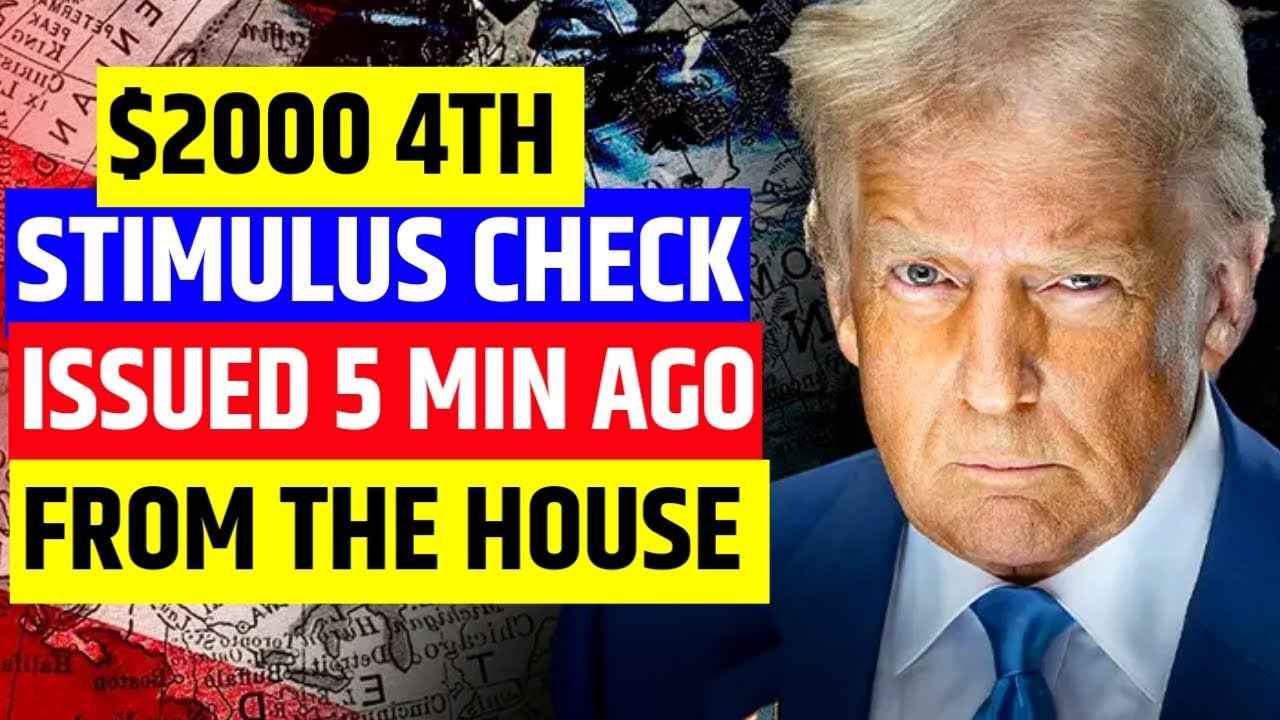Fourth stimulus check of $2,000 for all: With inflation continuing to take its toll on American households, discussions on a fourth federal stimulus check have resumed in Washington D.C. This time, the proposed amount is $2,000 for every eligible adult.
Fourth Stimulus Check: The ever-rising inflation has broken the back of millions of American families. The prices of everyday items like milk, pulses, bread, rent, health services and transportation are now becoming out of the reach of the common man. Although some relief has been given in government policies and taxes in the last few years, ordinary Americans are still facing difficulties in making ends meet due to economic instability.
Against this economic backdrop, discussions have once again begun on the fourth federal stimulus check. The proposal is being taken very seriously in Washington DC and its amount has been set at $2,000 per eligible adult. Although no formal legislation has been passed yet, growing public pressure and economic need have forced lawmakers to consider in this direction.
Who might be eligible for a fourth stimulus check?
If Congress plans another round of direct payments, eligibility will be the same as previous stimulus checks. The IRS will once again monitor the distribution of payments and use the latest tax returns or federal benefits records to determine who is eligible. Generally, eligible individuals include:
- Single applicants with annual incomes less than $75,000
- Married couples with combined incomes less than $150,000
- Heads of household with incomes up to $112,500
- Parents or caregivers may also receive additional payments for dependents
- Social Security, SSDI, and SSI recipients are expected to qualify
- The amount of the payment may also vary based on the number of dependents in the family.
Eligibility conditions: Are you eligible for this fourth stimulus check?
If this proposal passes, its eligibility is likely to remain the same as the earlier stimulus checks. This means that the IRS (Internal Revenue Service) will determine whether you are entitled to this relief based on your recent tax return or federal benefits record. Generally, the following citizens will be considered eligible:
- People with annual incomes below $75,000 and who are single return filers.
- Married couples with a combined income of less than $150,000.
- People who file returns as ‘head of household’ must have incomes up to $112,500.
- People who have dependents in their families—such as children, elderly or disabled members—can receive additional benefits.
- People who are already receiving government assistance such as Social Security, Small Scale Industries (SSI) or Small Scale Industries (SSD) can also be automatically included in the scheme.
Inflation and the severity of the economic crisis: Why do we need control?
Although there has been a slight improvement in the inflation rate by 2025, its impact continues to fall on the pocket of the common man. The huge increase in the prices of food to gas and medicines to rent has unbalanced the budget of the people. In such a situation, the fourth stimulus check proposed by the government is not only an economic aid, but it is also a symbol of the sensitivity of the government. For many families, this check can come as a new hope so that they can meet their basic needs.
Most affected groups: elderly, disabled and low-income people
In recent months, the government has increased social security benefits somewhat through cost-of-living adjustments (COLA), but these changes are not able to compensate for the rapidly rising inflation. In particular, elderly citizens, disabled and those with already limited income are most affected by this economic crisis. This impact of inflation is affecting their basic needs like medicines, food and housing. In such a situation, the fourth stimulus package can prove to be a lifesaver for them.
Decline in spending and impact on the market
Another big concern is that consumer spending has declined in recent times, which has directly affected small businesses, shops and local service providers. When people shop less, the economic cycle slows down and unemployment also starts increasing. In such a situation, the idea of a stimulus package has once again come to the fore – so that the purchasing power of families increases, demand comes in the market and the country’s economy can get back on track.
$2,000 relief amount and possible distribution time
According to the current proposal, eligible people can get a payment of $2,000. Also, an additional amount of $500 to $1,000 can also be given to each dependent of the family. However, this final amount will depend on the legislation passed in Congress. At the moment, there is no legislative approval on this until June 2025, but if this proposal is passed in the second half of this year, it may take a few months for the payment process to begin. This indicates that the funds can be distributed in late 2025 or early 2026.
People who have already opted for direct deposit will get the money first, while others will be paid via check or debit card.
What are the options if this plan doesn’t pass?
It’s true that even if this fourth stimulus check doesn’t become law, the government still has other relief plans available that can be implemented.
- An increase in the child tax credit for families with children
- Plans like LIHEAP that help with electricity and heating bills
- Emergency SNAP assistance, which can make it easier to buy food
- Rent assistance or housing vouchers
- Extension of unemployment benefits, which can provide immediate relief to people who have lost their jobs.
- These plans are evidence of the government’s commitment to not abandon the public in times of crisis.
What to do if the check is approved? How to prepare
While there has been no official announcement yet, there are some important steps you can take to prepare yourself for this payment:
- File your tax return and keep it updated.
- Enroll for direct deposit by visiting the IRS website.
- Keep an eye on the ‘Get My Payment’ tool when it’s back up and running.
- Avoid any scams and get information only from government websites.
- Your preparation will ensure that when this money arrives, you’re among the first to benefit.
Q: Has the fourth stimulus check been officially approved?
- No, as of now, Congress has not approved a fourth stimulus check of $2,000.
Q: Who may be eligible for a fourth stimulus payment?
- Individuals with annual incomes under $75,000, married couples with incomes under $150,000, and recipients of Social Security, Small Business Administration (SSI) or Small Business Development (SSD) may be eligible.
Q: How much money can I get?
- The proposed amount is $2,000 for each eligible adult, with an additional $500-1,000 for each dependent.
Q: When can stimulus checks be sent out?
- If approved in late 2025, payments could start arriving by late 2025 or early 2026.
Q: Will direct deposit be the fastest way to receive payment?
- Yes, those who have set up direct deposit with the IRS are likely to receive payments first.
Q: When can I get a fourth stimulus check?
- If Congress approves a fourth stimulus check, it could take several months for the IRS to implement a distribution system. Payments could arrive in late 2025 or early 2026.
Q: Who will be eligible for a fourth stimulus check?
- Eligibility will likely be similar to previous rounds. Single applicants earning less than $75,000, married couples earning less than $150,000, heads of households earning up to $112,500, and Social Security recipients may be eligible.
Q: How much will the fourth stimulus check be?
- The proposed amount is $2,000 per eligible adult, with additional payments for dependents. However, the final amount will depend on congressional approval.
Q: What happens if the fourth stimulus check doesn’t pass?
- If the fourth stimulus check doesn’t pass, other relief programs could be started or expanded, such as the child tax credit, housing assistance, or food assistance programs.
Q: How can I prepare for a fourth stimulus check?
- To prepare, make sure your tax filings are up to date, enroll in a direct deposit plan for faster payments, and keep an eye on official updates from the IRS.





